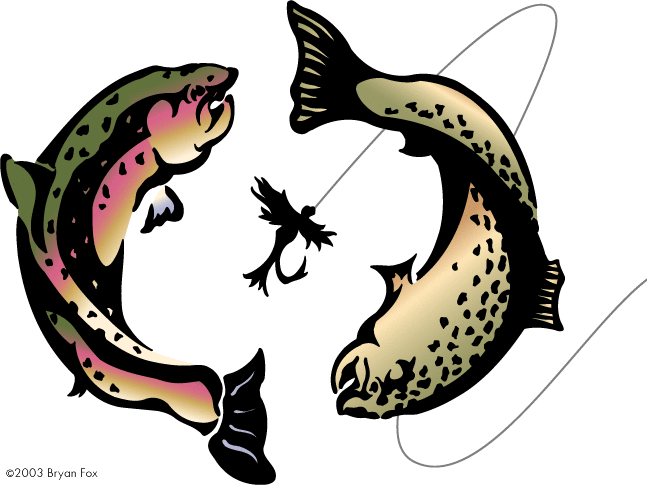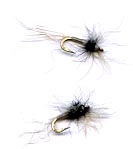
Illustration by Joseph R. Tomelleri
I‘ll be honest, I am not much of a Pacific Salmon fly fisherman. There are many reasons for this the first being I have more passion for pursuing trout, landlocked salmon and steelhead than I do the two species of Pacific Salmon that were introduced into the Great Lakes. Salmon runs on the Salmon River start as early as August. At that time of the year and into October the weather can be very nice. Nice fare weather combined with increasing numbers of big fish in the river will also bring out hoards of fisherman.
Years ago, when I first started fly fishing the Salmon River, I took a drive from South Utica, where I lived at the time, up to the river with my sights on fishing the Sportsman’s Pool. It was October 5th and I was pretty excited at the chance of hooking up with a salmon. I was up early and was at the parking lot well before sunrise. There were not many cars in the lot so that seemed encouraging. I walked to the river down the trail and had the head of the pool to myself when I arrived. It was still to early to start legally fishing so I checked over my gear to pass the time. As I waited more and more fisherman arrived at the pool on both sides of the river. By the time fishing was legal the pool was elbow to elbow with fisherman eager to fish. I never made a cast and decided to leave. I drove 30 minutes to Taberg and traveled north and decided to fish The East Branch of Fish Creek, a stream my father had taken me to fish many times as a child and teenager. The pool I picked was void of fisherman and I was excited to see trout rising to the surface. I spent the late morning casting elk hair caddis dry flies and caught a few nice browns. Though not a whopping pacific salmon it was a great day and just what I was looking for: some solitude, gorgeous weather, a beautiful trout stream, some room to cast and some rising trout.

Photo by Jessica Lettich
Over the years I have mostly avoided the Salmon River during the salmon run but a certain friend will convince me to give it a try from time to time. One time in the early fall of 2013, my buddy called and said “Let’s go up and give it a try, it can be a warm-up for steelhead.” I guess that was convincing enough so I decided to make the trip. Since that first trip to the Sportsman’s Pool back in the 90s, I have learned that the river is quite long and has over ten miles of public water below the dam at the lower reservoir. There are many spots to try and it’s possible to find a whole run to yourself during salmon season, even on a weekend.
Another thing that deters me from spending time pacific salmon fishing on the Salmon River is the techniques I see used to fish. I am by no means against putting a mild bit of weight on the leader to help the fly sink, but the amount of weight used by many fisherman is absurd. Overuse of split-shot can lead to lost flies and monofilament on the river bottom. Considering the amount of fisherman using excessive weight and consequently loosing gear in the Salmon River, its easy to imagine the accumulating waste on the river bed. Although snagging salmon was banned in 1994, the Salmon River seems unable to escape the snagging culture. I enjoy fly casting and Spey casting techniques to much to add excessive weight to the leader. When I fish for steelhead I choose to use floating lines with sinking leader systems so nice casting loops are still possible.

On one particular outing, September 28th, 2013, my buddy and I were fishing up river in the upper fly fishing only section of the Salmon River. It was in the afternoon, after a morning of no hook-ups and it was a perfect fall day on the river. I had decided to fish a bright fly that I had tied the night before. We found a nice section of water and there were no other anglers around. Afternoon on Sundays have become a good time for locals to fly fish as many anglers are heading home after the weekend. In this particular area, we could see fish moving up through the fast water, which is a perfect behavior to target salmon with a fly rod. I was fishing a 12 1/2 foot 8 weight spey-rod with a weight forward 9 weight spey line and a 3.9 inch per second sinking leader with 3 foot 12 pound tippet. I positioned myself well upstream of what looked like the main area fish were moving through. It was at the fast water tail-out of the pool and seemed to be about 2-3 feet deep. The area I was targeting was about halfway across the river. The river bent to the left below where I was standing. I stood far enough above the bend and the fish activity so I could get a nice slow swing and even get the fly to stop and dangle straight downstream into the seam the fish were moving through.

I made some casts and swung the fly through the tail-out; trying to keep the presentation slow by adding subtle mends and let the fly dangle in the current after the swing was completed. After a few casts as the fly was dangling in the current, the line went tight and I was hooked into something that grabbed the fly. After an intense fight with some jumps and runs up and down the pool, I was able to land a very dark but still healthy male Chinook Salmon. I was pretty happy and knew I had learned something that day. With a little patience to find a nice spot and thought towards presentation a King Salmon will aggressively hit a fly.






